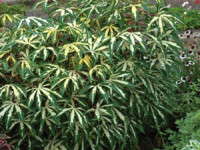In Search Of The Variegated Tapioca

The world of plants is changing. No, it has changed. New plants have become so important that even backyard gardeners are approaching breeders with Grandma’s plant in the hope they will obtain some royalties. It used to be that people wanted to introduce the plant to provide a legacy for Grandma, but times have changed. Larger companies have become so important in the introduction of new plants that it often becomes a numbers game. And the numbers, good grief, it seems that breeding companies and distributors almost dictate that a new plant must sell at least 10,000 liners, often more. If not, they pass.
We have made the introduction of Grandma’s plants more and more difficult by throwing up obstacles everywhere. First is the issue of patenting. Patenting costs money, therefore sufficient plants must be sold to pay for that. In order to do so, promotion of that plant is necessary, again requiring large numbers to be sold. The result of this insane rush to patent is that good, nay, great plants that are discovered in small nurseries or backyards will not be mainstreamed because they are unpatentable. The second great obstacle to plant introduction is that said plants must look good in containers in the spring. Of course, they must propagate easily, grow quickly and perform well in the landscape, but the container thing is a kicker to anything that grows more than 2 feet tall in the landscape. Forcing some plants to look good in a small container in the spring is tantamount to throwing bars up on the process of introducing new plants to the public. The third great obstacle is the belief that plants won’t sell after spring. These are not complaints, they are facts. We might be able to do something about the first two, the third has been argued about forever, and you know better than I if it is so.
If we can dispense with the first two for a few minutes, let’s pretend we actually want to introduce and/or sell plants that would be exceptional in the landscape or garden. Plants that really work! I can think of at least a dozen magnificent plants that 99 percent of the readers of this magazine would not know (i.e., would consider to be new), and would grow and sell if available. Plants that landscapers and consumers would enjoy and buy; plants that even look good in containers.
Perhaps such plants are not for the large breeders/distributors of the world, but the last time I looked there were still an awful lot of small- and medium-sized growers and distributors with loyal customers, all of whom are looking for something new. I love the statement of Mike Cole, the president of the excellent Western Horticultural Products (WeHoP) when he looked at me and said, “Allan, I don’t need to sell 10,000 liners to anyone. Give me something I can sell 100 to 100 customers.” I am not sure exactly what leaders like Mike are looking for, but they realize there is more to life than new geraniums, calibrachoas or petunias.
Here are a few you want to try out. These are plants that people come to screeching halts when they see. They aren’t out there in big numbers, but if I could find them, so can you. Start with a half dozen. Grow them on and try them out. None of the following plants can or should be patented, so forgitaboutit and let’s dispense with this silly goal of 10,000 or none. However, all have serious potential for excellent profit, so perhaps you might want to be like Mike.
Marble plant: Beautiful green and white foliage all season, looks good in a container, looks good as an edger in the landscape. Easy to grow, easy to propagate. Botanically, plants are known as Peristrope hyssopifolia.
Raggedy Ann: We are selling a bunch of copper plants (Acalypha) right now, what with plants like ‘Bourbon Street,’ ‘Red Threads’ and others. Everyone loves this mopdoll and although she is a little bigger than a calibrachoa, she is much easier to pronounce.
Edinburgh begonia: This entire begonia thing is beginning to rot my socks. Seems like there are dozens of fabulous begonias already out there ready to go. Many have been registered by the American Begonia Society but that does not mean more than 10 begonia fanatics have ever seen it. It just means it can’t be patented. Why not mainstream them and share such plants with the rest of the world. Don’t get me started about begonias we could do well with, but let me know if you need a few names.
Ornamental tapioca: If there is one plant everyone wants to know about, it is this one. The extraordinary variegated foliage, along with the red stems and petioles has everyone asking, “Where do I get this?” Plants are also known as variegated cassava; botanically Manihot esculenta ‘Variegata’
Rex begonia vine: I am not sure if anyone is interested in annual vines, I certainly am, and I grow a dozen or so different ones every year. Like begonias, I can think of a half dozen “new” vines that people would like to try. This one does not flower worth a darn, but my, the foliage is to die for. Plants are known botanically as Cissus discolor.
Cissus discolor









